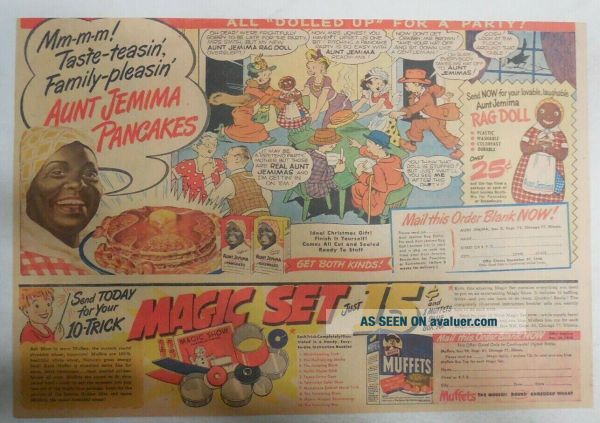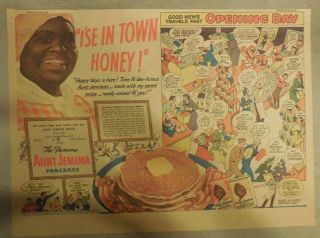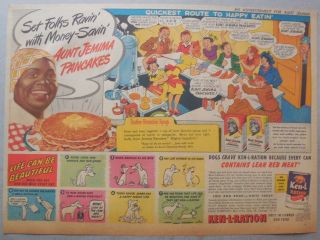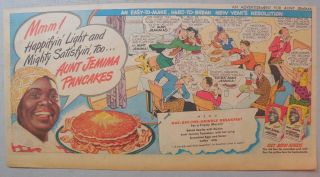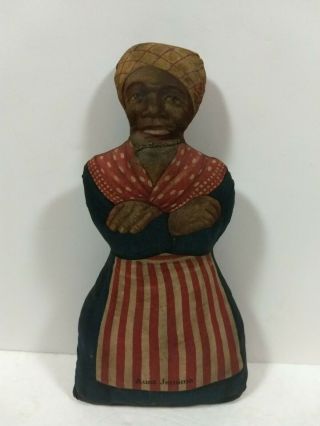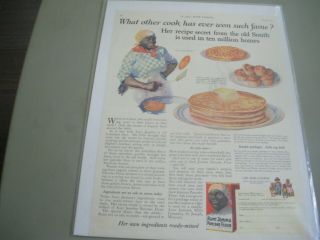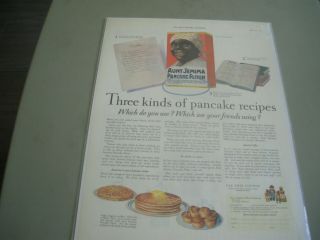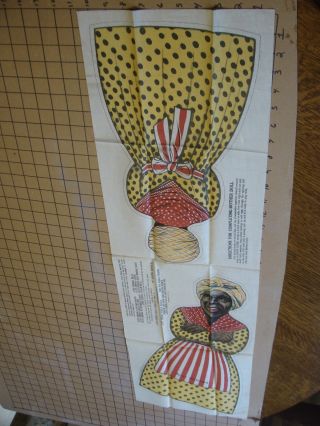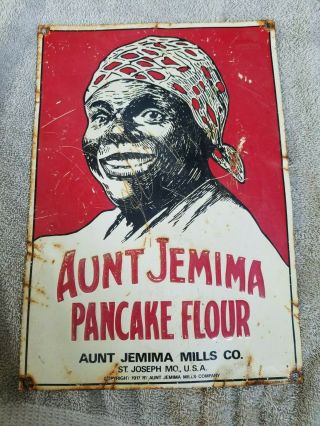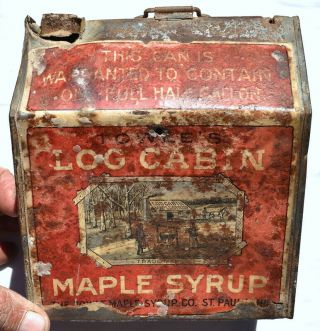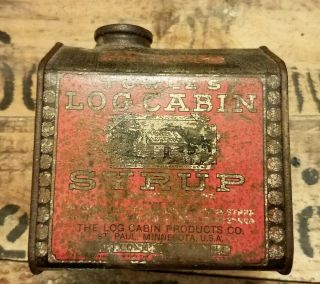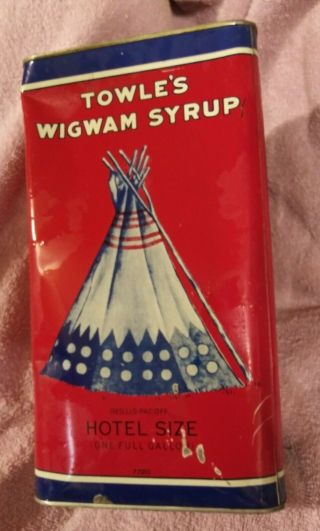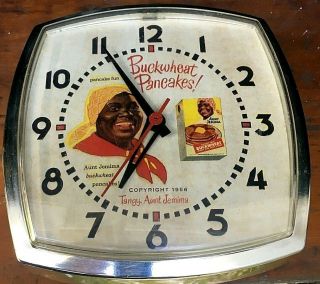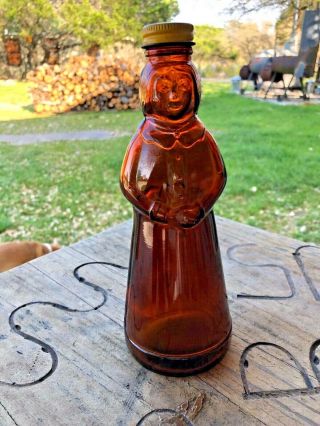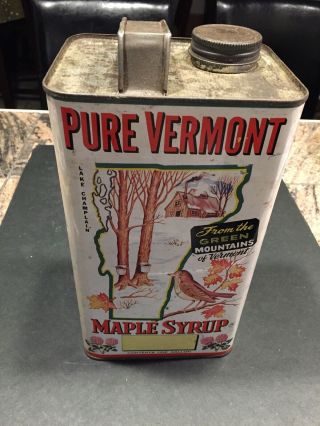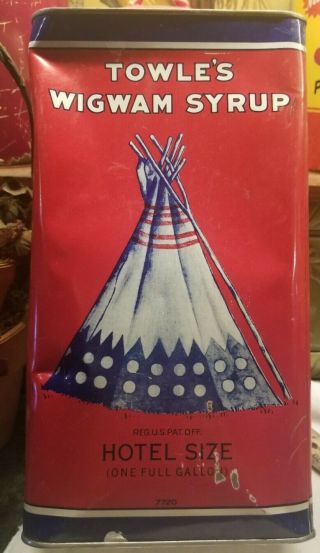Aunt Jemima Pancakes Ad: Rag Doll Premium 1930 ' S - 40 ' S 11 X 15in
Item History & Price
Aunt Jemima is a brand of pancake mix, syrup, and other breakfast foods. The Aunt Jemima pancake mix debuted in 1889, the first ready-mix, and became one of the most recognized brands in US history. By 1915 the brand had changed trademark law: the "Aunt Jemima Doctrine". The brand is currently owned by the Quaker Oats Company of Chicago, now a subsidiary of PepsiCo.The famous image of Aunt Jemima was based on the real image of Nancy Green, who was known as a magnificent cook, an attractive woman of outgoing nature and friendly personality, an original painting of which sold for $9, 030 at MastroNet. The painting was rendered by A. B. Frost, who is now well known as one of the great illustrators of the Golden Age of American Illustration.HistorySt. Joseph Gazette editor Chris L. Rutt, of St. Joseph, Missouri, and his friend Charles G. Underwood bought a flour mill in 1888. Rutt and Underwood's Pearl Milling Company faced a glutted flour market, so they sold their excess flour as a ready-made pancake mix in white paper sacks with a trade name (which Arthur F. Marquette dubbed the "first ready-mix"1889 Formula for Aunt Jemima mix:100 lb (45 kg) Hard Winter Wheat100 lb (45 kg) Corn Flour7 1⁄2 lb (3.4 kg) B.W.T. Phosphates from Provident Chem[ical] St L[ouis]2 3⁄4 lb (1.2 kg) Bicarb[onate] Soda3 lb (1.4 kg) Salt.However, Rutt and Underwood were unable to make the project work, so they sold their company to the Randolph Truett Davis Milling Company in St. Joseph, Missouri, in 1890.The Davis Milling Company was renamed Aunt Jemima Mills in 1913. By 1915, the Aunt Jemima brand was so well recognized that it changed trademark infringement precedent, the "Aunt Jemima Doctrine".The Quaker Oats Company purchased the Aunt Jemima Mills Company in 1926, and formally registered the Aunt Jemima trademark in April 1937. It remains one of the longest continually running logos and trademarks in the history of American advertising.Quaker Oats introduced Aunt Jemima syrup in 1966. This was followed by Aunt Jemima Butter Lite syrup in 1985 and Butter Rich syrup in 1991.Aunt Jemima frozen foods were licensed out to Aurora Foods in 1996, which in 2004 was absorbed into Pinnacle Foods Corporation.CharacterThe famous image of Aunt Jemima was based on the real image of Nancy Green, who was known as a magnificent cook, an attractive woman of outgoing nature and friendly personality. She was born into slavery on November 17, 1834, near Mount Sterling in Montgomery County, Kentucky. She was hired in 1890 by the R.T. Davis Milling Company in St. Joseph, Missouri, to represent "Aunt Jemima", an advertising character named after a song from a minstrel show. Davis Milling had recently acquired the formula to a ready-mixed, self-rising pancake flour from St. Joseph Gazette editor Chris L. Rutt and Charles Underwood and were looking to employ an African-American woman as a Mammy archetype to promote their new product. In 1893, Green was introduced as Aunt Jemima at the World's Columbian Exposition held in Chicago, where it was her job to operate a pancake-cooking display. Her amicable personality and talent as a cook for the Walker family, whose children grew up to become Chicago Circuit Judge Charles M. Walker and Dr. Samuel Walker, helped establish a successful showing of the product, for which she received a medal and certificate from the Expo officials. After the Expo, Green was offered a lifetime contract to adopt the Aunt Jemima moniker and promote the pancake mix. This marked the beginning of a major promotional push by the company that included thousands of personal appearances and Aunt Jemima merchandising. Nancy Green maintained her job with Davis Milling (which was renamed "Aunt Jemima Mills Company" in 1914) until her death in 1923; she was still working as Aunt Jemima at the time. A character named "Aunt Jemima" appeared on the stage in Washington, D.C., as early as 1864.The inspiration for Aunt Jemima was Billy Kersands' American-style minstrelsy/vaudeville song "Old Aunt Jemima", written in 1875. Rutt reportedly saw a minstrel show featuring the "Old Aunt Jemima" song in the fall of 1889, presented by blackface performers identified by Arthur F. Marquette as "Baker & Farrell". Marquette recounts that the actor playing Aunt Jemima wore an apron and kerchief, and Rutt appropriated this Aunt Jemima character to market the Pearl Milling Company pancake mix in late 1889.However, Doris Witt at University of Iowa was unable to confirm Marquette's account. Witt suggests that Rutt might have witnessed a performance by the vaudeville performer Pete F. Baker, who played characters described in newspapers of that era as "Ludwig" and "Aunt Jemima". His portrayal of the Aunt Jemima character may have been a white male in blackface, pretending to be a German immigrant, imitating a black minstrel parodying an imaginary black female slave cook.Beginning in 1894, the company added an Aunt Jemima paper doll family that could be cut out from the pancake box. Aunt Jemima is represented with her husband, Rastus (later changed to Uncle Mose avoiding confusion with the Cream of Wheat character), and their five children: Abraham, Lincoln, Dilsie, Zeb, and Dinah. The paper doll family was posed dancing barefoot, dressed in tattered clothing, and the box was labeled "Before the [recipe] was sold." Buying another box with elegant clothing cut-outs to fit over the dolls, the customer could transform them "After the [recipe] was sold." This placed them in the Horatio Alger rags-to-riches American cultural mythos.Rag doll versions were offered as a premium in 1909: “Aunt Jemima Pancake Flour/Pica ninny Doll/ The Davis Milling Company.” Early versions were portrayed as poor people with patches on the trousers, large mouths, and missing teeth. The children's names were changed to Diana and Wade. Over time, there were improvements in appearance. Oil-cloth versions were available circa the 1950s, with cartoonish features, round eyes, and watermelon mouths.Idealization of plantation lifeAlthough the character was not created until nearly 25 years after the American Civil War, the clothing and racist dialect of Aunt Jemima harked back to a glorified view of antebellum Southern plantation life as a happy slave. The myth surrounding Aunt Jemima's commercialization of her "secret recipe", family life, and plantation life contributes to the post-Civil War idealism of Southern life and America's developing consumer culture. Marketing materials for the line of products centered around the stereotypical mammy archetype, including the slogan first used at the 1893 World's Columbian Exposition in Chicago, Illinois: "I's in Town, Honey".Anna Julia Cooper used the World's Columbian Exposition as an opportunity to address how young African American women were being exploited by white men. She predicted the appeal of Aunt Jemima and the southern domestic ideal and went on to describe the north's fascination with southern traditions as part of America's “unwritten history”. Progressive African American women post emancipation saw Aunt Jemima's image as a setback that inspired a regression in race relations.[citation needed]One interpretation is that Aunt Jemima embodied an early 20th century idealized domesticity that was inspired by old Southern hospitality. There were others that capitalized on this theme, such as Uncle Ben's Rice and Cream of Wheat’s Rastus.LogoThe original version of the current Aunt Jemima logo was designed by H. Gene Miller, but he was unofficially credited. He also designed the original version of the current San Giorgio pasta company logo. James J. Jaffee, a freelance artist from the Bronx, New York, also designed one of the images of Aunt Jemima used by Quaker Oats to market the product into the mid-20th century.Just as the formula for the mix has changed several times over the years, so has the Aunt Jemima image been modified several times. In 1968, she was slimmed down from her previous appearance, depicting a more “svelte” look and wearing a white collar and geometric print “headband” still resembling her previous kerchief.In 1989, as she marked her 100th anniversary, her image was again updated, with all head-covering removed, revealing wavy, gray-streaked hair and gold-trimmed pearl earrings and replacing her plain white collar with lace. At the time, the revised image was described as a move towards a more “sophisticated” depiction, with Quaker marketing the change as giving her “a more contemporary look” and which remains on the products as of 2020.Outside the United States, the character still has her original mammy personality in advertisements and she is still referred to as the Aunt.RebrandingOn June 17, 2020, Quaker Oats announced that the Aunt Jemima brand would be replaced with a new name and image. The news came only days after the parody newspaper The Onion had published a satirical article about a similar, but fictional, announcement. The image will be removed from packaging later in 2020, while the name change will happen at a later date.PerformersThe R. T. Davis Milling Company hired Nancy Green as a spokesperson for the Aunt Jemima pancake mix in 1890, until her death on August 30, 1923. Nancy Green was born a slave in Montgomery County, Kentucky. As Jemima, Green appeared beside the "world's largest flour barrel" operating a pancake-cooking display at the 1893 World's Columbian Exposition in Chicago, Illinois.The African American Registry of the United States suggests Nancy Green and other individuals who played the caricature of Aunt Jemima should be celebrated in lieu of what has been widely condemned as a stereotypical and racist brand image. On Nancy Green's birthday, November 17, the registry wrote "we celebrate the birth of Nancy Green in 1834. She was a Black storyteller and one of the first black corporate models in the United States."Following Green's work as Aunt Jemima, the Quaker Oats Company no longer used a single woman to portray the role. They used different actors, many assigned regionally.Lillian Richard, a native of Fouke, Texas, was hired to portray Aunt Jemima in 1925, and remained in the role until she suffered a stroke in 1947. Richard is honored with a state of Texas historical marker in her hometown in Wood County, Texas.Anna Robinson was hired to play Aunt Jemima at the 1933 Century of Progress Chicago World's Fair. She was sent to New York City by Lord and Thomas to have her picture taken. "Never to be forgotten was the day they loaded 350 pounds of Anna Robinson on the Twentieth Century Limited." Other photos showing Robinson making pancakes for celebrities and used in advertising "ranked among the highest read of their time".Anna Short Harrington, born in 1897 in Marlboro County, South Carolina, began her career as Aunt Jemima in 1935. She had to support her five children, and she moved with her family to Syracuse, New York, where she cooked for a living. Quaker Oats discovered her when she was cooking at a fair. An ad in Woman's Home Companion in November 1935 said, "Let ol Auntie sing in yo' kitchen." It was her picture with a bandana used on Quaker Oats products. Harrington continued to play the role for 14 years, and she made enough money to buy a large house and rent rooms. That house was demolished to make way for Interstate 81. Harrington died in 1955. According to John Troy McQueen, author of The Story of Aunt Jemima, "she really was famous for cooking pancakes."Ethel Ernestine Harper was Aunt Jemima during the 1950s in person, in print and in media. She was the first Aunt Jemima to be depicted on TV and the final "living person" basis for the Aunt Jemima image until it was changed to a composite in the 1960s. She worked as a traveling "Aunt Jemima" on behalf of the Quaker company, giving presentations at schools, churches and other organizations. Prior to assuming the role, Harper graduated from college at the age of 17 and became a teacher.Rosie Lee Moore also portrayed the role of Aunt Jemima during the 1950s.The Aunt Jemima character received the Key to the City of Albion, Michigan, on January 25, 1964. An actress portraying Jemima visited Albion many times for fundraisers.LawsuitOn August 5, 2014, descendants of Anna Short Harrington filed a lawsuit in the U.S. District Court for the Northern District of Illinois against plaintiffs Quaker Oats and PepsiCo for $2 billion. The suit, which also named as defendants Pinnacle Foods and its former suitor Hillshire Brands, accused the companies of failing to pay Harrington and her heirs an "equitable fair share of royalties" from the pancake mix and syrup brand that uses her likeness and recipes. The lawsuit was dismissed with prejudice and without leave to amend on February 18, 2015.Pancake Capital of TexasHawkins, Texas, east of Mineola, is known as the "Pancake Capital of Texas" because longtime resident Lillian Richard portrayed Aunt Jemima for Quaker Oats from 1925 to 1947, traveling throughout the southern United States promoting Aunt Jemima pancakes. The local chamber of commerce decided to use Hawkins' connection to Aunt Jemima to boost tourism. In 1995 State Senator David Cain introduced Senate Resolution No. 73 designating Hawkins as the "Pancake Capital of Texas", which was passed into law; the measure was spearheaded by Lillian's niece, Jewell Richard-McCalla. The reason given by the chamber and by Senator Cain for the designation was "Hawkins has to be known for something!"Richard was born in 1891 and grew up in the tiny community of Fouke, Texas. When she was 20, she moved to Dallas, where she was hired by the Quaker Oats Company to promote making pancakes under the moniker "Aunt Jemima". She did so for 23 years, until she suffered a stroke in 1948. She returned to Fouke, where she lived until her death in 1956. Richard was honored with a Texas Historical Marker dedicated in her name on June 30, 2012.SlangThe term "Aunt Jemima" is sometimes used colloquially as a female version of the derogatory label "Uncle Tom". In this context, the slang term "Aunt Jemima" falls within the "mammy archetype" and refers to a friendly black woman who is perceived as obsequiously servile or acting in, or protective of, the interests of whites.The 1950s television show Beulah came under fire for depicting a "mammy"-like black maid and cook who was somewhat reminiscent of Aunt Jemima.[citation needed]In popular cultureThe 1933 novel Imitation of Life by Fannie Hurst features an Aunt Jemima-type character, Delilah, a maid struggling in life with her widowed employer, Bea. Their fortunes change dramatically when Bea capitalizes on Delilah's family pancake recipe to open a pancake restaurant that attracts tourists at the Jersey Shore. It becomes a great success and eventually is packaged and sold as Aunt Delilah's Pancake Mix. The Academy Award-nominated 1934 film version of Imitation of Life starring Claudette Colbert and Louise Beavers retains this part of the plot, which was excised from the 1959 remake of Imitation of Life starring Lana Turner and directed by Douglas Sirk. They achieve success due to selling flour with a smiling Delilah on the box dressed in Aunt Jemima fashion.Aunt Jemima, a minstrel-type variety radio program, was broadcast January 17, 1929 – June 5, 1953, at times on CBS and at other times on the Blue Network. The program had several hiatuses during the overall span."In the 1960s, Betye Saar began collecting images of Aunt Jemima, Uncle Tom, Little Black Sambo, and other stereotyped African-American figures from folk culture and advertising of the Jim Crow era. She incorporated them into collages and assemblages, transforming them into statements of political and social protest.[47] The Liberation of Aunt Jemima is one of her most notable works from this era. In this mixed-media assemblage, Saar utilized the stereotypical mammy figure of Aunt Jemima to subvert traditional notions of race and gender.Frank Zappa includes a song titled "Electric Aunt Jemima" on his 1969 album Uncle Meat. Electric Aunt Jemima was the nickname for Zappa's Standel guitar amplifier.Faith Ringgold’s first quilt story Who's Afraid of Aunt Jemima? (1983) depicts the story of Aunt Jemima as a matriarch restaurateur."Burn Hollywood Burn" on Public Enemy's 1990 Album "Fear of a Black Planet" features Big Daddy Kane commenting on the updating of racial tropes with the lyrics, "And black women in this profession / As for playin' a lawyer, out of the question / For what they play Aunt Jemima is the perfect term / Even if now she got a perm."[49] Spike Lee's 2000 film Bamboozled features Aunt Jemima (played by Tyheesha Collins) as one of the dancing "pickaninnies" in the film's deliberately racist TV show Mantan: The New Millennium Minstrel Show, alongside other stereotypical black antebellum South characters like Rastus.The 2004 mockumentary C.S.A.: The Confederate States of America features numerous depictions of Aunt Jemima-type characters as slaves (referred to as servants) in an alternate timeline in which the Confederacy won the American Civil War.In the South Park episode "Gluten Free Ebola" (2014), Aunt Jemima appears in Eric Cartman's delirious dream to tell him that the food pyramid is upside down.*Please note: collecting and selling comics has been my hobby for over 30 years. Due to the hours of my job I can usually only mail packages out on Saturdays. I send out First Class or Priority Mail which takes 2 - 7 days to arrive in the USA and Air Mail International which takes 5 - 30 days or more depending on where you live in the world. I do not "sell" postage or packaging and charge less than the actual cost of mailing. I package items securely and wrap well. Most pages come in an Archival Sleeve with Acid Free Backing Board at no extra charge. If you are dissatisfied with an item. Let me know and I will do my best to make it right.Many Thanks to all of my 1, 000's of past customers around the World. Enjoy Your Hobby Everyone and Have Fun Collecting!
00340



